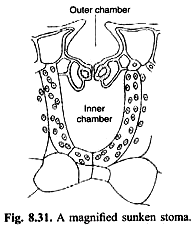What is Sunken Stomata ?
Definition
Sunken Stomata can be defined as a type of stomata that are located below the surface of a plant leaf or stem, as opposed to being on the surface. Sunken stomata are found in plants that live in arid or semi-arid environments, as it helps to reduce water loss by minimising the amount of leaf surface exposed to the air. Sunken stomata also help to protect the plant from damage caused by high levels of sunlight or extreme temperatures.
Discovery of Sunken Stomata
- Sunken stomata were first described in 1864 by the German botanist Wilhelm Pfeffer.
- He observed that these stomata were found exclusively on the underside of leaves and that they were not visible from the upper surface.
Location of Sunken Stomata
- Sunken stomata are found in the lower surface of a plant leaf.
- They can also be found on the stem or other aerial parts of a plant.
- Location of Sunken stomata is beneficial for plants living in arid or semi-arid environments as it helps to reduce water loss by minimising the amount of leaf surface exposed to the air.
- The lower surface of the leaf receives less sunlight and is generally cooler than the upper surface, which can help to protect the plant from damage caused by high levels of sunlight or extreme temperatures.
- The location of sunken stomata provides better shade for photosynthetic cells and a better place for water and nutrient absorption.
Also Check – Mechanism of opening and Closing of the Stomata
Structure of Sunken Stomata
- The structure of sunken stomata is unique in that they are formed by the invagination or folding of the leaf epidermis.
- This creates a small depression around the stomatal opening, which is where the guard cells and subsidiary cells are located.
Types of Sunken Stomata
- Sunken stomata can be divided into two main types: distal and proximal.
- Distal sunken stomata are found near the leaf margins.
- Proximal sunken stomata are found closer to the leaf’s center.
Also Check – Stomatal Transpiration
Functions Of Sunken Stomata
- The function of sunken stomata is thought to be related to water regulation.
- The sunken structure of these stomata creates a small reservoir of water around the stomatal opening, which helps to keep the guard cells hydrated.
- This allows the plant to maintain a healthy water balance and prevent water loss through the stomata.
- Additionally, the sunken structure may also offer some protection to the stomata from the sun and wind, helping to prevent damage or injury.
- Overall, sunken stomata are an important adaptation that allows plants to better regulate their water balance and protect their stomata from environmental stressors.
Also Check – What is the Function of Stomata ?
Examples of plants with Sunken Stomata
Sunken stomata found in plants that live in arid or semi-arid environments, where water is scarce and the risk of desiccation is high. Examples of plants that have sunken stomata are cacti, succulents, and desert plants. Sunken stomata are also found in some aquatic plants that live in shallow water and are exposed to the air for long periods of time. They are also found in certain species of xerophytic plants, which are adapted to survive in dry environments by reducing water loss.
Also Check – How do the Guard cells Regulate Opening and Closing of Stomatal Pores


One Comment on “Sunken Stomata”